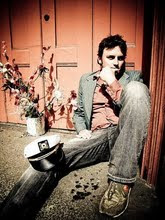
East Portal MUNI stop
Lower Haight
Saturday morning
***
I was born at Mt. Zion hospital, in the old wing at Post and Scott, before San Francisco was a "knowledge center" full of "thought leaders," in the dead zone between the counterculture revolutions and the technology boom. They don't have a birth wing any more. It's a cancer research center now. Which you know, I might be grateful for someday too.
In 1986, my bedroom window at Vermont & Mariposa looked at the sunset over Sutro tower. The other side of it seemed like a foreign land, like on the other side might be the other side of the world, where someone had told me their sun comes up when ours goes down and they start their day as we are going to bed. It didn't occur to me that on the other side of it was just the Sunset, where we had moved to Potrero Hill from a house at 2206 39th Avenue. A Chinese family had bought it in probate and wanted to sell it to my parents. They had it appraised around $108,000. My dad couldn't really see the value in it, and neither was really ready for the commitment.
During the day I went to Katherine Michiels' School at 1335 Guerrero, where we made our own vegetarian lunches and made up rap songs about farm animals and social justice. After school, I played in Dolores Park or ate quesadillas from La Cumbre at 515 Valencia. I still do both of those things on a fairly regular basis. My mom bought duck sausage at a butcher on Mission Street and made things that tasted like New Orleans, where she had lived briefly before moving to San Francisco.
From our house on Vermont Street, we walked to Goat Hill Pizza and Farley's. There used to be a make-your-own teddy bear factory near the Anchor Steam brewery somewhere, and mine was a fat one named Farley. They only TV channel I was permitted to watch (on a black & white set with an antenna) was KQED, which I knew was where Sesame Street lived, a few blocks away at the bottom of the hill. But it was a big hill to a small girl, and the few short blocks seemed an enormous distance from the Slovenian Hall to McKinley Square.
I believe early childhood in Potrero Hill was, spatially, one of the most positive impacts on my cognitive development. The relationship of the industrial flats to the neighborhood ascending the hill, the freeway as a visual and psychological border, and the mix of residential and commercial uses all worked together to subvert the conventions that are taught to American children as the "proper" kind of neighborhood to live in, while being exactly the most salutary kind of neighborhood to live in. The city in the eighties was a real, live Sesame Street; presenting the languages of plurality and urbanism at the most formative time, so that homogeneous single use residential areas would always seem wrong and foreign.
Of course, I couldn't articulate any of that until one day in college, when I worked for my dad in the dispatch center at Luxor Cab Co. In my downtime, I pored compulsively over the reverse phone directory and made indexes on a map of callers' old telephone exchanges, addresses, and real estate listings. I was obsessed with the movement of people, where they lived and worked, where they went, and what of the city was leftover from before. The young dispatcher I worked with on Sunday mornings told me I should consider urban planning as a vocation, and lent me a copy of Jane Jacobs' The Death & Life of Great American Cities. He's a MUNI driver now, and I see him occasionally on the system around town. There's never time to thank him for illuminating my purpose, and I keep meaning to return his copy of the book.
It was the most incredible revelation; here was the lens through which I see the world, perfectly articulated and preceding me by forty years. To this day, it informs so much of what I think and talk about. I went on to study most of the rest of Jacobs' body of work, but even now I keep a copy of The Death & Life next to my bed for quick-reference, finding it as prescient and useful as ever on an almost daily basis. I can hardly speak about anything without relating it back to the built environment or transit infrastructure or demographics or history; it bores the snot out of my friends but frankly, I don't care to think about things any other way.
I'll never be cured of this.









2 comments:
it's good to know more about the area than the news tidbits I've picked over the years - it's much more than Jerry Garcia.
I love this shot of Megan with MUNI in the background. It's really awesome. :)
Looking forward to working with you on Sunday.
Post a Comment